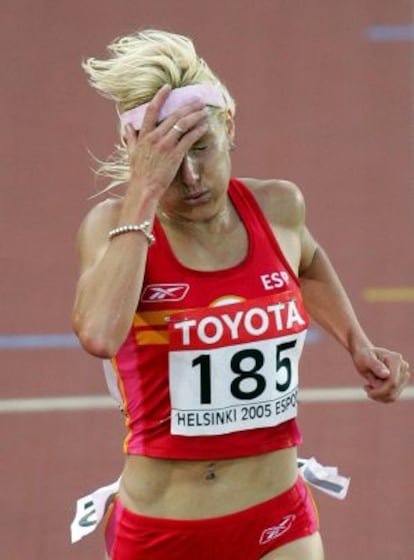Was Domínguez a Puerto patient?
New documents suggest runner and PP senator has links with doping doctor Eufemiano Fuentes

New documents emerging from the Operation Puerto doping trial suggest that Marta Domínguez, the most successful Spanish athlete of all time and Popular Party senator for Palencia since 2012, was allegedly a client of main defendant Eufemiano Fuentes from at least 1997.
A photocopied document from a confirmed source, to which EL PAÍS has had access, shows that a patient with the codename MARTA DGZ visited Fuentes’ office on December 17, 1997 and supposedly underwent diverse performance-enhancing doping treatments, including autotransfusions of blood.
Among the bags of plasma and blood seized by Operation Puerto investigators are two marked with the code Urco and dating April 20, 2006, according to Civil Guard reports. In order to persuade the judge to allow for DNA analysis of their contents, Puerto prosecutors have compiled a list of sportspersons corresponding to the codes and nicknames marked on the bags. On the list, according to several sources, the name of Marta Domínguez is associated with the code “9-Urco.”
Domínguez’s lawyer José Rodríguez has told EL PAÍS in a written statement that his client, who was also investigated in the now-shelved Operation Greyhound doping trial, denies having had a doctor-patient relationship with Fuentes, as well as having ever used a banned substance or method. “My client wants to make it known that she will sue for personal and/or civil liabilities deriving from any article published containing affirmations that are not true or that contain damaging opinions.”
Domínguez, who has never tested positive for doping, has said on several occasions that she has known Fuentes for years through his wife, the former athlete Cristina Pérez.
“How am I going to dope if I pass a control practically every day?” she once asked rhetorically in a TV interview.
The December 1997 visit to Fuentes is reflected in a document written in the doctor’s handwriting, and bearing the letterhead of the Grupo Deportivo Kelme, the cycling team of which he was medical director. After identifying the patient as 22 years of age — Domínguez would have been 22 at that time — and 52-56 kilos, it ends with a recommendation: “Start very light treatment with...,” followed by a drawing of a dot enclosed by a circle, which is a symbol for EPO in other documents. That winter Domínguez, who had already won a European indoor medal in 1996 and reached the world indoor final in 1997, won another European medal and the national indoor championship.
Domínguez’s name also appears to be linked to sheet 755 of the Operation Puerto indictment, which shows a schedule headed with the reference MZD 2005. That year, the long-distance runner began training in May after recovering from an injury.
The schedule shows that the patient was meant to begin with an EPO treatment and a blood extraction on May 2, continuing until June 14. On that day the administration of IGF-1 on alternate days was due to start, continuing until August 3.
Competition dates
The dates marked as important competition days — with three vertical arrows — coincide exactly with Domínguez’s schedule for that year: June 4, Seville; July 8, Rome Golden Gala; July 16, Madrid; August 10-13, Helsinki World Championships. Four days before competitions, a reinfusion of two bags was scheduled (marked with an R). In Helsinki, Domínguez reached the final of the 5,000 meters where she finished 14th, which she attributed to the little preparation time she had had following her injury.
The schedule figures on a fax sent by José Alonso Valero, Domínguez’s manager, on June 2, 2005. The telephone number belongs to EurobestRun in Pozuelo de Alarcón in Madrid, Alonso Valero’s agency.
In the Operation Greyhound case, Alonso Valero had declared that an email from his banker in Andorra included the codenames of clients with accounts there. One of them, 420486, corresponded to Urco. The identity of the account holders was carried out using their dates of birth. One of these was November 3, 1975, that of Domínguez, who also had a dog named Urco. As cyclists Ivan Basso and Jörg Jaksche recently admitted to the Puerto trial judge, Fuentes used the names of his clients’ dogs as codes for the bags of blood.
Tu suscripción se está usando en otro dispositivo
¿Quieres añadir otro usuario a tu suscripción?
Si continúas leyendo en este dispositivo, no se podrá leer en el otro.
FlechaTu suscripción se está usando en otro dispositivo y solo puedes acceder a EL PAÍS desde un dispositivo a la vez.
Si quieres compartir tu cuenta, cambia tu suscripción a la modalidad Premium, así podrás añadir otro usuario. Cada uno accederá con su propia cuenta de email, lo que os permitirá personalizar vuestra experiencia en EL PAÍS.
¿Tienes una suscripción de empresa? Accede aquí para contratar más cuentas.
En el caso de no saber quién está usando tu cuenta, te recomendamos cambiar tu contraseña aquí.
Si decides continuar compartiendo tu cuenta, este mensaje se mostrará en tu dispositivo y en el de la otra persona que está usando tu cuenta de forma indefinida, afectando a tu experiencia de lectura. Puedes consultar aquí los términos y condiciones de la suscripción digital.









































